We test the Wilier Urta Hybrid: the brand's first lightweight e-MTB
The Urta Hybrid is Wilier's first lightweight e-MTB and is positioned halfway between XCO and Down Country, a segment that is generating more and more interest among those who are considering getting an electric mountain bike. We've had the chance to test it for several weeks and here we tell you everything you need to know about it.
Wilier Urta Hybrid: lightweight, powerful and 120 mm of travel
The Wilier Urta Hybrid is based on a carbon frame very similar to its muscular version, the Wilier Urta SLR. The same construction process and carbon treatment has been used, but in this case it is more robust as it houses the motor and battery, something that has not affected to achieve a refined design and the electrical section is so well integrated that at first glance it appears to be a regular mountain bike.
With 120 mm of travel in the fork and shock, the Urta Hybrid has a monopivot rear suspension system linked to an aluminium linkage that, together with the use of the carbon flex, manages to give the desired travel. The design of the crank follows the lines of the frame bringing harmony to the overall design and the junction of the chainstays with the bottom bracket is covered with a very well finished rubber protector that prevents the entry of dirt.
RECOMENDADO

Complete list of the highest paid cyclists of 2025

How many calories are burned when cycling

What is heart rate variability and how does it affect the cyclist?

Change wheels if you want to transform your bike's behavior

What bike size do you need? Here's how to find out

How does age affect performance and recovery?

The generous wheel arch allows 2.4" tyres to be mounted without having to worry about mud accumulation problems. And the frame is adapted for the SRAM UDH derailleur hanger and post mount brake caliper mount.
One feature to note is the possibility of fitting 2 bottle cages in their normal position. This makes it possible to carry water even when mounting the range extender.
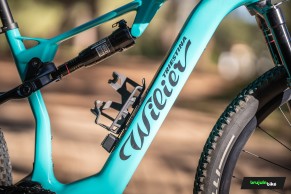
As already mentioned, the electrical system is well integrated, as is the cable routing throughout the frame. With the exception of the accumulation of cables in the cockpit area, something we think there is room for improvement. The cables enter the frame through the front of the head tube. They are held in place by a small rubber band which, despite not being the right size for the entry hole, does its job perfectly well. We also miss a steering stopper, which protects the frame against possible crashes. This is something that, in our opinion, all mid-range and high-end bikes on the market should have.
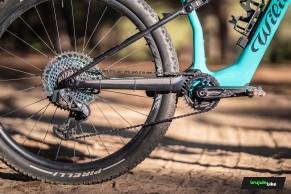
Weighing in at just over 16 kg, the Wilier Urta Hybrid is here to break the e-MTB scene and trends.
XCO geometry adapted to the needs of e-MTBs
The geometry of the Urta Hybrid takes current cross-country trends and adjusts them to the requirements of an e-MTB, resulting in a harmonious concept with a slightly steeper head angle, specifically 66.7°, and a 74° saddle angle. The chainstay length has been increased to 448 mm and remains constant across all sizes. The reach has also been modified to adapt to the trend of longer designs, for this purpose it has been increased by 5 mm with respect to the muscular Urta, although as we will see later it is still a fairly compact bike.
In general terms, it has sought to ensure greater stability while riding by increasing the wheelbase.
Its frame is available in 4 sizes; S, M, L and XL.
Fazua Ride 60 motor and 430 Wh battery: balance between power and range
The Fazua Ride 60 motor is the heart of the Urta Hybrid. This lightweight motor has undergone a complete overhaul with numerous technical innovations. It has a rated power of 250 watts, although it can reach a maximum of up to 450 watts in boost mode. Powered by a 430 Wh battery that is integrated into the frame's down tube, the Urta Hybrid offers a power and range that puts it above most lightweight e-MTBs on the market.

As the name suggests, the motor is capable of developing 60 Nm of torque. This system, weighing just 1.96kg, features three levels of assistance called Breeze, River and Rocket, all of which are preset and cannot be customised, although as we'll see below there are a number of ways to get fully customised profiles via the Fazua app. The fairly compact motor has improved frame mounting, helping to provide surprisingly powerful support with little to no noise.
The 430Wh battery is fully integrated into the down tube so as not to break the lines of the frame, but in return it cannot be removed. Weighing in at 2.3kg, it displays its charge level via Fazua's LED indicator, located near the headset and within sight of the handlebars. This indicator also displays the selected assistance mode in 4 colours that are clearly visible even on the sunniest of days.

A USB-C port, under the LED indicator module, facilitates the transfer of updates to the bike, allows the motor system to be checked and gives the possibility to charge external elements with the bike's battery. In our opinion, it would be a good option to provide the module with some kind of automatic locking and magnet type security, to limit the ease of opening.
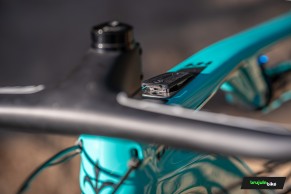
The battery charging port is equipped with a magnetic connection system that prevents incorrect positioning of the cable. It is located in a small box under the down tube bottle cage, protected by a magnetic cover that is easy to open.
The set has the possibility of incorporating a 210 Wh range extender, which is placed in the bottle cage of the down tube to increase its autonomy in the most demanding routes.
Minimalist remote control
The system is operated from a remote control located next to the left hand grip, a minimalist and ergonomically designed control ring which, depending on the way it is operated, can manage the different motor modes. Starting from off, leaving it pressed upwards for a few seconds, we switch the system on. With light touches up or down we move between the 3 "permanent" modes and by holding it down for 2 seconds we have access to 2 "short" modes.
The three permanent levels offered by Fazua Ride 60 are: Breeze for gentle support even with low pedalling power, River more progressive and forceful, in which the assistance depends precisely on the pedalling power exerted by the biker and Rocket to face the most demanding climbs using moderate pedalling power.
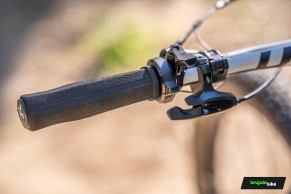
They are complemented by the two short modes. The Boost mode, for when the power of the Rocket mode is not enough. Activated by pressing the circular control upwards for 2 seconds, the motor releases its maximum power of 450 watts for 12 seconds, ideal for getting you out of trouble. This mode is easily identified by the power boost and flashing LEDs on the control unit. There is also a Walk mode, a walking aid that is activated by pressing and holding the circular control.
It's a system that can compete with more powerful e-bikes while being small and light enough to compete with lightweight e-MTBs.
A full featured and easy to use App
Through Bluetooth connection and the FAZUA App we can link our smartphone with the bike. In this way we can record our routes, create and modify assistance levels, receive news, updates...
Undoubtedly, the greatest use will be focused on the management of the different modes or riding profiles. As we said before, the 3 default modes are not modifiable, but we have something better, the possibility to duplicate the profile and modify it as we wish. That way we can have different profiles focused, for example, to the different uses we give to the Urta Hybrid.
In addition, it also gives you the possibility to create a profile by means of a questionnaire or download it directly from the Fazua Profile Store. Through a few simple questions Fazua creates the profile that best suits your riding. Of course, these profiles are fully configurable and you can always modify them according to your needs.
Within each profile you will find the 3 assistance modes, where you can modify the maximum power, how many watts of pedalling the maximum power is reached and the acceleration.
On the other hand, from the Fazua website you can download for free the basic version of Fazua Toolbox, a practical software in which you can obtain a lot of information about the system, you can make modifications, updates, error analysis... All you need is a USB-C cable between the bike and the computer.
Setup
The Wilier Urta Hybrid comes in 4 equipment levels. Our test unit was the top of the range model.
It is equipped with a Sram drivetrain, more specifically the XX1 Eagle AXS, combined with Miche aluminium cranks. It has a 10-52T cassette gearing and a 32-tooth chainring, a very versatile combination.

For the suspension, RockShox SID 35 Ultimate 120 mm fork and a RockShox Deluxe Ultimate shock. A combination worthy of any muscular down country bike. Together with the kinematics of the Wilier frame they provide comfort and optimal absorption of irregularities.
The brakes are provided by Shimano, with its XT version, which together with 180 mm discs at the front and 160 mm at the rear provide powerful braking.
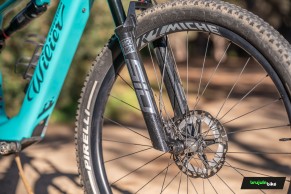
Of particular note is the dropper post, made by Kind Shock Ragei, with 80 mm of travel. It has a good feel and its performance has been exemplary in all our tests. This same model is fitted to all versions of the Urta Hybrid.
The 30mm Miche K6 Carbon rims and 2.4-inch Pirelli Scorpion XC M tyres are an ideal combination to maintain the weight/comfort ratio, as well as providing good traction.
Finally, Wilier features the integrated handlebar and stem set used on the Urta SLR. Made from a single piece of carbon, it adds a distinctive touch to the Urta Hybrid's aesthetics, although it does limit personal adjustability.
Riding with the Wilier Urta Hybrid
As soon as we got on it, we confirmed what we had seen at first glance: it is a compact bike, which offers a very compact position on it. The feeling it gave us the first few days was almost like riding a size smaller. That's what you might notice when you get on it if your previous bike had a generous reach, as is the case with most of today's bikes. However, it's something you get used to quickly, because it helps it feel more manageable in all situations.

On climbs, where it feels most comfortable
The Wilier Urta Hybrid retains its essence in this respect. Despite having the assistance, its lightness and racing character make you pedal with persistence, even if you're not in your best shape.
On steep and technical slopes it handles with docility, as its geometry and short suspension travel mean that its front wheel always stays in contact with the ground and we only have to worry about pedalling.
When it's time to stand up, it allows you to pedal with ease, and it doesn't feel bulky and heavy.
The frame feels stiff, even when in Boost mode. The rear end doesn't rock uncomfortably, but it is active, asking us to lock the suspension if we want to optimise our performance to the maximum.
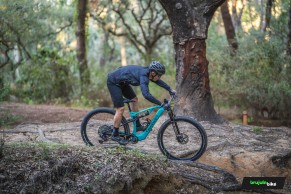
The motor's power delivery is linear and the assistance is not very intrusive during continuous pedalling, for example on long climbs. However, on shorter, steeper climbs where more power is used, the Fazua Ride 60 motor's assistance is noticeable.
For our day-to-day riding, Breeze was the mode we used the most, as it provides enough assistance to compensate for the extra weight, while still requiring you to push hard on every climb. The River mode was used to tackle more technically complex climbs. And Rocket mode, which we didn't use much, but which can be a great ally when your strength is already flagging and you reach a very demanding climb.
On this bike with its generous climbing qualities, a remote shock lockout is missing. Its light weight invites you to pedal at speed and in certain situations it becomes uncomfortable or almost impossible to release one hand from the handlebars to lock the rear suspension.
The motor assistance is fairly quiet, especially in Breeze mode, but there is a slight whistling noise from River mode onwards, which increases as you increase your cadence. Even so, on most off-road surfaces, this sound mimics the tyres' own rolling noise.
Downhill
Downhill it has everything you'd expect from a down country bike. Its 120 mm of travel is fully usable and although it doesn't have those extra millimetres that we find on a more powerful e-MTB, they are more than enough to defend itself on all descents. This, somewhat of a disadvantage, is compensated by its light weight, which allows us to move it more easily and take it to the desired line with little effort.

It gives a feeling of confidence, except on steep slopes where the front end is more heavily loaded than usual due to the position on the handlebars. Something that leads us to use the dropper post more often. In our opinion, the 80 mm of travel is sufficient for the routes we rode, but in the case of more aggressive routes, it might be a good option to opt for a seatpost with more travel.
The rear end is active and filters out any irregularities to perfection, leaving the tyre on the ground at all times. The combination of Miche carbon wheels and Pirelli Scorpion XC tyres give good traction and cornering support.
Overall it maintains a good ratio between its downhill ability and the fun it provides. The low centre of gravity gives it stability at high speeds and its compact geometry makes it very manoeuvrable.
On the plain, the right place to extend autonomy
It is perhaps the terrain where it stands out the least, but it is the point where you can optimise the autonomy of the battery. With it, it's easy to ride above its 25 km/h limit, at which point the motor stops providing assistance. When the motor is not working, it acts in the same way as when it is off, without offering any perceptible resistance, so you won't feel the need to make use of the assistance, saving battery life and making the routes longer.
If we talk about autonomy, as we always say, it is a very variable data depending on the characteristics of the biker and the route that is being done. Even so, our experience has been very satisfactory. We have been able to do routes of 70 kms and about 1,500 metres of elevation gain and arrive with more than 20% of battery. In addition, in the event of running out completely, its light weight will allow us to get home comfortably.
On a day-to-day basis, we found only one drawback. The Fazua's remote control is not completely rigid, and the left hand grip was not completely fixed, which sometimes caused the control to remain pressed down, turning the unit off or activating the Boost mode.
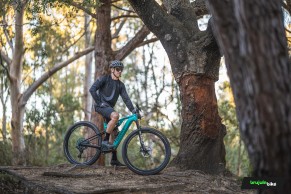
Conclusion
The Wilier Urta Hybrid is a true electric cross-country bike, with the qualities of a lightweight e-MTB, but with slightly more power and range. It has a design focused on sporty riding, a low weight and a geometry optimised to prioritise performance, without neglecting safety in its handling. The assistance provided by the Fazua Ride 60 is powerful in its more aggressive modes and smooth and natural in Breeze mode. It's not extremely quiet but you won't notice its sound most of the time.
It is aimed at those bikers who want to enjoy the benefits of an e-MTB and at the same time want to finish their rides with that feeling of having made an effort at all times.
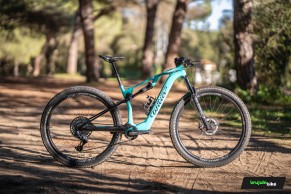
Wilier Urta Hybrid: setup and price
- Frame: Urta Hybrid Carbon HUS-MOD.
- Fork: Rockshox SID Ultimate (120 mm)
- Shock: Rockshox Deluxe Ultimate (120 mm)
- Crankset: Miche, ALU, 32T.
- Rear derailleur: SRAM XX1 Eagle AXS
- Shifter: SRAM Eagle XX1 SL-AXS
- Brakes: Shimano XT BR-M8100, 2 pistons, Shimano discs Front:180 mm Rear:160mm.
- Chain: SRAM Eagle XX1 RAINBOW
- Cassette: SRAM Eagle XX1 XG 1299 10-52T RAINBOW
- Wheels: Miche K6 Carbon, 30 mm int.
- Tyres: Pirelli Scorpion XC M Pro Wall 29 x 2,4”
- Handlebar: Cockpit Urta Bar, 760 mm
- Seatpost: Drop KS RAGEi
- Saddle: Prologo Proxim
- Motor: Fazua Ride 60, 450 W, 60 Nm
- Battery: Fazua 430Wh
- Display: Centro LED Fazua
- Price: 12.500€